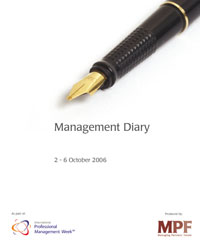
|
http://www.patrickmckenna.com/blog
Page << Prev 70 71 72 73 74 75 76 77 78 79 Next >> of 95
Post #232 - Saturday, September 1, 2007
The Extraordinary Law Firm
I was delighted to receive an unexpected courier package yesterday from the kind folks at the Association of Legal Administrators. Inside the package was a personalized letter that read:
“Dear Patrick: As a leader in the legal consulting profession and as someone who works with and provides support to many law firms, I’d like to make you aware of some important and exciting new initiatives being undertaken by ALA. These initiatives are designed to help firm managers transform their offices into remarkable workplaces that deliver superior client service and provide great satisfaction for each and every person who is part of that effort.”
Apparently the ALA has embarked on a campaign to make your firm a great place to work!
 Their campaign includes a conference debuting in early 2008, a special issue of their journal Legal Management, dedicated to this subject; and a new book entitled, The Extraordinary Law Firm. Their campaign includes a conference debuting in early 2008, a special issue of their journal Legal Management, dedicated to this subject; and a new book entitled, The Extraordinary Law Firm.
“Its message is so important that I wanted to provide you with a copy, with my compliments. Authored by Chuck Stinnett, a recognized authority in the legal management profession, The Extraordinary Law Firm includes actual case studies that describe how the featured firms have distinguished themselves and achieved a reputation for being the best the profession has to offer.”
The author draws from 12 case studies (including prestigious firms like Alston Bird, Bingham McCutchen, Nixon Peabody and others who were acknowledged by Fortune Magazine) to create specific checklists for firms of any size to use.
This text also includes a forty-page section on ideas to make your firm a better place to work. Included among a rich array of suggestions was references to and material drawn from my two books: First Among Equals and Herding Cats.
Thanks Chuck, I’m honored to be included.
Post #231 - Friday, August 24, 2007
Facing The Challenges of Management
The United Kingdom-based Managing Partners’ Forum (MPF) has produced a Management Diary as part of its contributions to International Professional Legal Management Week – to be celebrated from October 1st to 5th, 2007.
 This 20-page publication spotlights the many issues firm leaders face and is designed for daily use in This 20-page publication spotlights the many issues firm leaders face and is designed for daily use in chronicling and tackling those on-the-job challenges. As Nigel Knowles (Joint-CEO of DLA Piper) stated in the Introduction; The Diary highlights the many challenges faced by busy managing partners and their management teams. It aims to provoke us into thinking critically about our role, our effectiveness and the way we use our time. It aims to raise wider awareness of the varied work and styles of managing partners. It includes inspirational thoughts and nuggets of management wisdom. Try to make it an uncensored account of your activities, thoughts and feelings. chronicling and tackling those on-the-job challenges. As Nigel Knowles (Joint-CEO of DLA Piper) stated in the Introduction; The Diary highlights the many challenges faced by busy managing partners and their management teams. It aims to provoke us into thinking critically about our role, our effectiveness and the way we use our time. It aims to raise wider awareness of the varied work and styles of managing partners. It includes inspirational thoughts and nuggets of management wisdom. Try to make it an uncensored account of your activities, thoughts and feelings.
I can’t help it, I really think that this is one insanely cool and innovative idea. Kudos to an old friend, UK-based Kim Tasso (a twenty-year veteran of legal marketing and change management)who did the real heavy lifting in spearheading, developing and writing this diary. WELL DONE!
Click here to download a PDF copy of this unique management tool.
Post #230 - Wednesday, August 22, 2007
Management’s Burning Issues
 Each year, in August, we survey firm leaders and ask them to identify for us their ‘Burning Issues’ – those critical business concerns having to do with strategy, growth, practice management, professional development . . . or whatever, that are currently occupying their leadership agendas. Each year, in August, we survey firm leaders and ask them to identify for us their ‘Burning Issues’ – those critical business concerns having to do with strategy, growth, practice management, professional development . . . or whatever, that are currently occupying their leadership agendas.
Rather than posing the usual open-ended question to managing partners, this year we tried a different twist. We asked firms to please force rank a list of thirty-eight (38) possible Burning Issues and identify ONLY those SIX (6) that for now, are right at the top of their management agendas. And of course, number 38 was labeled “other” so as to allow respondents to identify whatever was of concern that we may have missed.
Monday being the official cut-off date, we were delighted to have received a total of 137 completed (a record number) responses for this annual survey. 63 percent came from firms of 100 to 300 attorneys, 15% from firms of 301 to 500 attorneys, and 22% from those firms of over 500 – a good representation of the AmLaw 100 and 200 lists!
Another nuance in this year’s study is the surveying of Chief Operating Officer / Executive Director professionals. For the first time, we will be able to compare and see if the COO’s are identifying the same Burning Issues as the firm leaders identified.
Obviously there is a lot of data to sort through and analyze, but here's a teaser:
“Some of the possible burning issues that we were surprised did not score highly with the managing partners of any of the three different categories of law firms, included:
- expansion by way of the further opening of offices, either on a domestic or international basis;
- devoting serious attention to using technology to deliver legal services to clients;
- handling corporate procurement departments (increasingly involved in the retention and evaluation of outside counsel); and
- any experimentation with methods of outsourcing as a means of controlling costs.”
Stay tuned. There is so very much more to come.
Post #229 - Thursday, August 16, 2007
How Biased Are You?
Diversity has featured prominently in legal circles for so long now that the business imperative for firms to embrace it should be abundantly clear.
 Then I came across this . . . a Harvard research initiative entitled: Project Implicit has designed a series of fourteen (14) online tests to measure your unconscious prejudices regarding such subjects as religion, weight, disability, sexuality, race and age . . . What’s that you say??? Then I came across this . . . a Harvard research initiative entitled: Project Implicit has designed a series of fourteen (14) online tests to measure your unconscious prejudices regarding such subjects as religion, weight, disability, sexuality, race and age . . . What’s that you say???
Like it or not, and in spite of the most powerful diversity initiatives, our human tendency to express personal bias is far more deeply rooted than any of us explicitly cares to admit. For example, height and attractiveness are empirically correlated with more positive first impressions and higher salaries in the corporate world.
At the Harvard project, tests strive to reveal one’s hidden biases by exposing the underlying attitudes and beliefs toward social groups and politics. They take images of people from different social groups, such as young versus old, thin versus fat, straight versus gay. Participants first associate words with the pictures along conventional lines (e.g., a picture of a thin person and the word “good”) and then you are asked to reverse associations (thin with “bad”). The system analyzes your speed in making the associations; such that the longer it takes for you to associate “thin” and “bad”, the stronger the indication of unconscious bias in favor of thin people.
I don’t have the space to explain how the tests work, but I can tell you that they are relatively short and straightforward. May I suggest that you spend a few minutes and take one of these fourteen tests for yourself. Just go to: http://implicit.harvard.edu
What is most interesting is that since 1998, more than 4.5 million tests have been administered and some fifteen thousand tests are completed each week. A startling pronouncement – Project Implicit has found that roughly 90 percent of participants harbor biases, including negative views of one’s own ethnic group.
Even more startling (you’d better sit down for this one) . . . the scores do NOT change with repeated testing!!! Even knowing how the test works and having taken it before does not enable you to overpower your imbued biases.
Post #228 - Thursday, August 9, 2007
Managing Virtual Teams
When David Maister and I were finalizing the various chapters for First Among Equals, one of the drafts that was left on the cutting-room floor had to do with managing virtual teams or practice groups that were geographically spread across different locations and often, different time zones. It was a subject that was highly complex with numerous professional service firms reporting huge frustration and claiming that the answer was not a simple matter of improved technology.
 Since that time, it has been my good fortune to meet and have the opportunity to work with Dr. Karen Sobel Lojeski. Karen and I have had the opportunity to co-present at a Globalization Conference and collaborate on a couple of client assignments. Karen holds the title of CEO (Chief Evangelist Officer) with Virtual Distance International, a Wall Street based firm that she founded last year. Since that time, it has been my good fortune to meet and have the opportunity to work with Dr. Karen Sobel Lojeski. Karen and I have had the opportunity to co-present at a Globalization Conference and collaborate on a couple of client assignments. Karen holds the title of CEO (Chief Evangelist Officer) with Virtual Distance International, a Wall Street based firm that she founded last year.
One of the things that I learned while working with Karen was the shocking degree to which performance is affected when members of any group are geographically dispersed (even when that dispersion is on the same floor, in the same building). Here’s but one small example from Karen’s research:
Where members are dispersed and collaboration occurs via IT, the performance factors most affected:
• Trust among group members was lower by 83%
• Innovative behavior diminished by 93%
• Job satisfaction was lower by 80%
• Goal and role clarity degraded by 62%
• Success measures including on-time, on-budget performance and customer satisfaction were 50% lower
• Corporate citizenship behavior was lower by 47%
• Leader effectiveness was diminished by 30%
According to an issue of Strategy & Business:
"Lojeski developed the notion of Virtual Distance as a Ph.D. candidate at the Stevens Institute of Technology, after conducting a series of surveys and interviews with hundreds of large enterprises to analyze the difficulties companies were having in organizing successful virtual work teams. She was struck by an unexpected finding: The prevailing view, that teams underperform primarily because they are too widely dispersed geographically or among different organizations, was not quite accurate. Poor performance, Lojeski learned, occurred just as frequently among work teams whose offices or cubicles are on the same floor — people who are virtually, but not physically, distant from each other.
Under Lojeski’s taxonomy, three sets of factors can contribute to Virtual Distance. The first is Physical Distance —geographical, temporal, and organizational — which has an impact on the success of projects but doesn’t on its own create Virtual Distance. The second is Operational Distance, which includes the size of the team, how often it meets face to face, its degree of multitasking on projects for other teams, and how skilled its members are at using the technological tools at their disposal. These operational elements are the easiest to change, but modifying these alone will not necessarily have a significant long-term influence on team performance if other concerns persist in hampering the group effort.
The third — and by far the most important — factor involves what Lojeski calls Affinity Distance: the degree to which team members share cultural values, similarities in communication style, and attitudes toward work; how much team members feel dependent on one another for their own success; how often team members have worked together before or whether they belong to the same social networks; and the degree to which each team member’s status derives from his or her position in the organizational hierarchy and/or contribution to the team or the work effort. Reducing the adverse repercussions of these factors is difficult, but it can have the largest impact on a team’s output."
Fortunately those who would wish to learn more need only wait until next March, when Karen’s first book, Uniting the Virtual Workforce will be available from Wileys.
Meanwhile, she has now finalized the program for an Annual Conference on Managing Virtual Distance, which she tells me is going to be covered by many of the major press outlets. It is being produced by IIR and they expect at least several hundred people. Have a look. As you can see they have quite a “who’s who” of speakers for this event.
Post #227 - Tuesday, August 7, 2007
Leadership Reflections
What’s more important than helping others do a good job with completing their client assignments and actually getting enjoyment from their work?
What’s more important than teaching others about the business development side of the practice so they (and you) will be more successful?
What’s more important than following through on your commitments to the partners with whom you work?
What’s more important than setting a good example for others to follow?
Post #226 - Tuesday, August 7, 2007

When the rate of change inside an organization is slower than the rate of change outside the organization, the end is in sight.
Jack Welsh, Chairman, General Electric
Post #225 - Thursday, August 2, 2007
 What You Do Today Matters What You Do Today Matters
A great deal has been written on the value of building relationships (Questions of Character, A Way of Being, The Likeability Factor, How to Win Friends and Influence People, Love is the Killer App, The Luck Factor, The Experience Economy, Trust-Based Selling, The Trusted Advisor, Extraordinary Relationships, Book Yourself Solid).
A great deal has been written about the importance of creating strong networks and interpersonal skills in today's global world (Re-imagine, The World is Flat, Competing for the Future, Cultural Intelligence).
And a great deal has been written about how to developing our emotional and social intelligence (Working with Emotional Intelligence, Primal Leadership, Social Intelligence, Put Your Best Foot Forward, First Impressions) to most effectively work with and through others.
Sadly, however, I find little evidence that these principles are being lived and certainly not all that often by those so busy reading all the above. It is as if we struggle to translate all that we know to our day-to-day actions. Or, perhaps it is that we fail to recognize the leadership opportunity when it arrives because it rarely feels as glamorous as we hoped it would.
What I have learned is that the application of all we are busy reading about or taking courses in can only ever be lived in the moment. Reading more articles, books (even mine!), and taking more leadership courses will not provide significant value if we cannot apply all that we already know now. What you do today matters.
Post #224 - Thursday, August 2, 2007
New Oil & Gas Development?
I noticed a obscure little news item today that talked about Russia literally planting its flag on the North Pole, earlier this week . . .
Apparently President Putin ordered a mini-sub full of explorers and scientists to dive over 2 miles below the pole’s surface and plant a meter-high, rust-proof titanium flag on the bottom of the ocean. ‘We are here to define the outer limit of Russia’s territory,’ Artur Chilingarov, leader of the expedition, told reporters, as if that wasn’t painfully clear already.
‘This isn’t the 15th century,’ our Canadian Foreign Minister Peter MacKay responded in an uncharacteristically aggressive statement (for Canuck standards). ‘You can’t go around the world and just plant flags and say we’re claiming this territory.’
Speculators have guessed that up to 18% of the world’s oil rests under the artic circle . . . and don’t we all know that wars have started over far pettier chunks of land. At the very least, a global oil grab is clearly emerging.
Post #223 - Wednesday, August 1, 2007
Your Past Success Is Your Future Vulnerability
Former Microsoft COO, Bob Herbold says success creates nine dangerous traps for companies today. In his new book Seduced by Success; How the Best Companies Survive the 9 Traps of Winning, Herbold thoroughly examines 44 different companies to illustrate the traps. today. In his new book Seduced by Success; How the Best Companies Survive the 9 Traps of Winning, Herbold thoroughly examines 44 different companies to illustrate the traps.
'You have to constantly move, evolve, improve and innovate.' Many organizations “think they have found the secret that will lead to everlasting success. Little do they know that by turning their previously successful practices into legacy practices that they follow continually, they’re putting themselves in a very disadvantageous position,” Herbold says. “Once they reach some level of success they tend to lose their sense of urgency.”
Herbold’s Nine Traps:
1 Neglect: Sticking with yesterday’s business model
2 Pride: Allowing your offerings to become outdated
3 Boredom: Clinging to successful branding after it becomes stale and dull
4 Complexity: Ignoring business processes as they become cumbersome and complicated
5 Bloat: Rationalizing your loss of speed and agility
6 Mediocrity: Condoning poor performance and letting your stars languish
7 Lethargy: Getting lulled into a culture of comfort, casualness and confidence
8 Timidity: Not confronting turf wars, infighting and obstructionists
9 Confusion: Unwittingly providing schizophrenic communications
'If you think you've got it all figured out, watch out.' Just as soon as you have it all figured out, or that you think you have it all figured out, watch out. Because there’s some bright idea out there that’s going to take your business away and that’s the mentality that you have to keep,” Herbold says. “It’s all about continually getting yourself ahead of the marketplace.” The goal, he says, is for managers to “keep their eyes wide open for the success-induced traps, and be willing to acknowledge that you’re never done. You have to constantly tackle the future.”
Page << Prev 70 71 72 73 74 75 76 77 78 79 Next >> of 95
|
|


 Ashridge House
Ashridge House  11226 - 60 Street
11226 - 60 Street  Edmonton, Canada
Edmonton, Canada  T5W 3Y8
T5W 3Y8